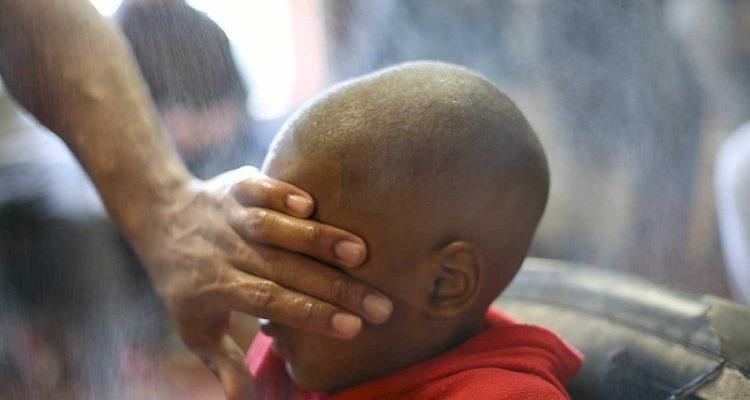Film festivals are hyperbole’s rookery. If you need convincing, try reading festival programming notes or, better still, put your eye holes on festival reviews as journalists feverishly crank out piece after piece, screening after screening; the scramble to beat everyone else to the punch and find the Next Big Thing™ before the rest of the pack is real and often inimical to the movies they champion. Hype, to an extent, is an understandable and even natural component of the festival dynamic, but if the verbiage sounds far-fetched, it probably is. Approach with caution.
But make an exception for “Hale County This Morning, This Evening,” the rare gem to live up to self-imposed promises made by programmers, critics, and publicists lured by festival temptations of magnified response. The “why” is simple: You haven’t seen “Hale County This Morning, This Evening” before. You’ve probably seen movies that echo in “Hale County This Morning, This Evening” — the freeform tone poems of Terrence Malick, the human clipshow of Kirsten Johnson’s “Cameraperson,” the rhythmic, unfussy films of Frederick Wiseman. But RaMell Ross has an element on his side that these artists lack — a level of honesty attained only through intimacy. Ross knows his subjects as more than subjects. He knows them as you know your friends, your family, your neighbors.
Good documentarians get to know their subjects, of course, but it’s easy to imagine Ross on the other side of the lens, a subject in another inquisitive, empathetic mind’s documentary about the ebb and flow of life in Hale County, Alabama. He understands the area and its inhabitants because he’s one of them, which is to say he understands his subjects in ways most documentary filmmakers will envy. “Hale County This Morning, This Evening” pulses with that hyper-specific familiarity, capturing in just an hour and sixteen minutes the passage of years through both long static takes and fleeting, blink-and-you’ll-miss-it moments of profound mundanity. Sweat drips from a young man identifiable only by his feet, dribbling to the concrete in lockstep with the basketball in his hands; Ross then cuts to stone pavers as they’re splashed by a rainstorm.
“Hale County This Morning, This Evening” presents us with the everyday, but Ross’ presentation gives the everyday dimension. You can’t tell a story over the span of literal years in just an hour; it’s challenging enough to try that in a two hour film or a ten hour television series. But Ross isn’t necessarily interested in doing that, in condensing human existence — namely that of two humans in particular, Quincy and Daniel, two black teens residing in the town of the film’s title — into an astoundingly compact parcel. His preference for pole-vaulting through time affirms as much. “Hale County This Morning, This Evening” could be described as a collage of Quincy and Daniel’s lives, assembled from bits and pieces of their day to day, each varying in size.
Quincy wrestles with his son, Kyrie, on the couch while his partner, Boosie, sits unimpressed by their roughhousing. (Ross cuts to an intertitle as soon as she walks away. “Carrying twins now, Boosie careth not about the film.”) Daniel, a student at Selma University, runs basketball drills, circling the paint and lining up his shots as Ross follows along, his camera locked to his athletic form as he carries out his practice with clockwork precision. We watch cotton fields passing by as Ross films Alabama from the window of a car, the sounds of a school basketball game playing in the background. There’s a timeless weight assigned to these images; the routines most of us would write off as trivialities are, through Ross’ eyes, made recognizable as individual pieces of a greater whole. “Hale County This Morning, This Evening” is humbly existential. Ross prefers to let his material speak for itself than pronounce the film’s greater meaning.
The closest he comes to hand-holding his audience occurs at the half hour mark, when he takes a trip to a disused plantation house and cuts from the drive to its doorstep to footage of Bert Williams, a vaudevillian blackface performer, sneaking peeks to camera, as if observing Ross’ arrival in a fit of suspicion. “Hale County This Morning, This Evening” is a Southern film through and through, but no scene in the film better illustrates the link between the past and present of America’s Black Belt; Ross remarks effortlessly on the still-standing reminders of the country’s past racism and the role they play in its current racism. It’s the longest he lingers on the subject of prejudice, with other signifiers, like a brief roadside encounter with the police, providing buttressing corroboration for Ross’ commentary.
Racism isn’t the film’s focal point, though, and when considering the splintered parts in context with one another we understand why: “Hale County This Morning, This Evening” is about black identities, and though these identities are shaped in part by systemic bigotry, they’re shaped by other factors too. Life, death, ambition, failure, joy, anguish, the abstract, and the intangible; whether in Ross’ prolonged sequences, in the seconds-long fragments of the commonplace, or in the truly awesome time-lapse photography, where the sun falls or rises and life’s parade scurries by in as much of a rush to get where it’s going as festival-going critics are to publish copy ahead of the next guy. (And so life imitates art.)
“Hale County This Morning, This Evening” demands much of its audience on a first watch, to say nothing of a second or third watch. You won’t unravel its meaning after a single viewing, either. But that’s the film’s greatest pleasure. Like life itself, “Hale County This Morning, This Evening” doesn’t lend itself to immediate comprehension. It’s to Ross’ credit that his work remains so thoroughly accessible and engrossing regardless. [A]
Click here for our complete coverage from the 2018 Sundance Film Festival

